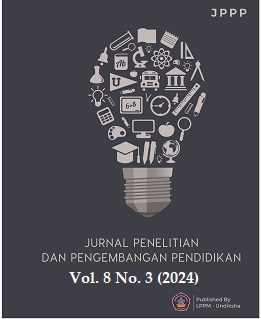Undergraduate Students' Perceptions of Online Learning Post Pandemic Covid-19
DOI:
https://doi.org/10.23887/jppp.v8i3.83990Keywords:
Student, Perception, Undergraduate, Online Learning, Post PandemicAbstract
After the COVID-19 pandemic. network-based learning has become a necessity and habit for many universities in Indonesia. This research focuses on the problem of student's lack of participation in online learning through virtual meetings. The purpose of this study is to analyze undergraduate students' perceptions of online lectures. This study used a quantitative approach with a survey method. involving 233 students from the Faculty of Teacher Training and Education as respondents. The data collection method used was a questionnaire with an instrument in the form of a questionnaire sheet. After the data was collected. it was analyzed using the descriptive statistical analysis method. Based on the findings of this study. students' perceptions of online learning overall are at a high level. especially on the aspect of flexibility. which is rated very positively. However. some aspects need more attention. primarily related to the effectiveness of online learning in improving academic achievement and reducing boredom. It can be concluded that while students appreciate the flexibility and convenience of online learning. there is a need to improve the quality of the learning process to make it more effective and meaningful for students. The implication is that universities need to develop more interactive. meaningful and engaging online learning strategies to increase student participation. In addition. more varied types of assignments and the use of technology that supports more collaboration will increase the effectiveness and satisfaction of online learning in the future.
References
Abbasi. S.. Ayoob. T.. Malik. A.. & Memon. S. I. (2020). Perceptions of students regarding E-learning during Covid-19 at a private medical college. Pakistan Journal of Medical Sciences. 36(COVID19-S4). S57. https://doi.org/10.12669%2Fpjms.36.COVID19-S4.2766. DOI: https://doi.org/10.12669/pjms.36.COVID19-S4.2766
Ahmed. H.. Allaf. M.. & Elghazaly. H. (2020). COVID-19 and medical education. The Lancet Infectious Diseases. 20(7). 777–778. https://doi.org/10.1016/S1473-3099(20)30226-7. DOI: https://doi.org/10.1016/S1473-3099(20)30226-7
Al-Ahdal. A. (2020). Overcoming pronunciation hurdles in EFL settings: An evaluation of podcasts as a learning tool at Qassim University Saudi Arabia. Asian EFL Journal Research Articles. 27(1). 86–101. https://www.researchgate.net/publication/340493341.
Alammary. A. S. (2024). Optimizing Components Selection in Blended Learning: Toward Sustainable Students Engagement and Success. Sustainability. 16(12). https://doi.org/10.3390/su16124923. DOI: https://doi.org/10.3390/su16124923
Ali. W. (2020). Online and Remote Learning in Higher Education Institutes: A Necessity in light of COVID-19 Pandemic. Higher Education Studies. 10(3). 16. https://doi.org/10.5539/hes.v10n3p16. DOI: https://doi.org/10.5539/hes.v10n3p16
Almahasees. Z.. Mohsen. K.. & Amin. M. O. (2021). Faculty’s and Students’ Perceptions of Online Learning During COVID-19. Frontiers in Education. 6(15). https://doi.org/10.3389/feduc.2021.638470. DOI: https://doi.org/10.3389/feduc.2021.638470
Almaiah. M. A.. Al-Khasawneh. A.. & Althunibat. A. (2020). Exploring the critical challenges and factors influencing the E-learning system usage during COVID-19 pandemic. Education and Information Technologies. 25(6). 5261–5280. https://doi.org/10.1007/s10639-020-10219-y. DOI: https://doi.org/10.1007/s10639-020-10219-y
Alqurashi. E. (2019). Predicting student satisfaction and perceived learning within online learning environments. Distance Education. 40(1). 133–148. https://doi.org/10.1080/01587919.2018.1553562. DOI: https://doi.org/10.1080/01587919.2018.1553562
Asmadi. A. (2004). Pendekatan Kualitatif dan Kuantitatif serta Kombinasinya dalam Penelitian Psikologi. Pustaka Pelajar. https://onesearch.id/Author/Home?author=Asmadi+Alsa.
Balogun. N. A.. Adeleke. F. A.. Abdulrahaman. M. D.. Shehu. Y. I.. & Adedoyin. A. (2023). Undergraduate students’ perception on e-learning systems during COVID-19 pandemic in Nigeria. Heliyon. 9(3). e14549. https://doi.org/10.1016/j.heliyon.2023.e14549. DOI: https://doi.org/10.1016/j.heliyon.2023.e14549
Bazán-Ramírez. A.. Capa-Luque. W.. Ango-Aguilar. H.. Anaya-González. R.. & Cárdenas-López. V. (2023). Perception of Peruvian Students Studying in Biological Sciences about the Advantages of Virtual Classes during the COVID-19 Pandemic. Education Sciences. 13(6). https://doi.org/10.3390/educsci13060626. DOI: https://doi.org/10.3390/educsci13060626
Bird. K. A.. Castleman. B. L.. & Lohner. G. (2022). Negative impacts from the shift to online learning during the COVID-19 crisis: Evidence from a statewide community college system. Aera Open. 8(11). https://doi.org/10.1177/23328584221081220. DOI: https://doi.org/10.1177/23328584221081220
Bono. R.. Núñez-Peña. M. I.. Campos-Rodríguez. C.. González-Gómez. B.. & Quera. V. (2024). Sudden transition to online learning: Exploring the relationships among measures of student experience. International Journal of Educational Research Open. 6(2). 100332. https://doi.org/https://doi.org/10.1016/j.ijedro.2024.100332. DOI: https://doi.org/10.1016/j.ijedro.2024.100332
Broadbent. J.. & Poon. W. L. (2015). Self-regulated learning strategies & academic achievement in online higher education learning environments: A systematic review. The Internet and Higher Education. 27(1). 1–13. https://doi.org/10.1016/j.iheduc.2015.04.007. DOI: https://doi.org/10.1016/j.iheduc.2015.04.007
Croxton. R. A. (2014). The role of interactivity in student satisfaction and persistence in online learning. Journal of Online Learning and Teaching. 10(2). 314. https://www.scirp.org/reference/referencespapers?referenceid=2383424.
de la Varre. C.. Keane. J.. & Irvin. M. J. (2011). Enhancing Online Distance Education in Small Rural US Schools: A Hybrid. Learner-Centred Model. Journal of Asynchronous Learning Networks. 15(4). 35–46. https://doi.org/10.1080/09687769.2010.529109. DOI: https://doi.org/10.24059/olj.v15i4.205
de Oliveira. M. M. S.. Penedo. A. S. T.. & Pereira. V. S. (2018). Distance education: advantages and disadvantages of the point of view of education and society. Dialogia. 29(1). 139–152. https://doi.org/10.5585/dialogia.N29.7661. DOI: https://doi.org/10.5585/dialogia.N29.7661
Ehlers. U.-D.. Pawlowski. J. M.. Ehlers. U.-D.. & Pawlowski. J. M. (2006). Quality in European e-learning: An introduction. Handbook on Quality and Standardisation in E-Learning. 1–13. https://link.springer.com/book/10.1007/3-540-32788-6. DOI: https://doi.org/10.1007/3-540-32788-6_1
Elshami. W.. Taha. M. H.. Abuzaid. M.. Saravanan. C.. Al Kawas. S.. & Abdalla. M. E. (2021). Satisfaction with online learning in the new normal: perspective of students and faculty at medical and health sciences colleges. Medical Education Online. 26(1). 1920090. https://doi.org/10.1080/10872981.2021.1920090. DOI: https://doi.org/10.1080/10872981.2021.1920090
Eom. S. B.. Wen. H. J.. & Ashill. N. (2006). The determinants of students’ perceived learning outcomes and satisfaction in university online education: An empirical investigation. Decision Sciences Journal of Innovative Education. 4(2). 215–235. https://eric.ed.gov/?id=EJ1063425. DOI: https://doi.org/10.1111/j.1540-4609.2006.00114.x
Feng. Q. I.. Zhang. Q.. Du. Y.. Ye. Y.. & He. Q. (2014). Associations of physical activity. screen time with depression. anxiety and sleep quality among Chinese college freshmen. PloS One. 9(6). e100914. https://doi.org/10.1371/journal.pone.0100914. DOI: https://doi.org/10.1371/journal.pone.0100914
Fraenkel. J. R.. Wallen. E. N.. & Hyun. H. H. (2012). How to Design and Evaluate Research in Education (Eight Edit). McGraw-Hil. https://www.scirp.org/reference/referencespapers?referenceid=1046940.
Garrison. D. R.. & Kanuka. H. (2004). Blended learning: Uncovering its transformative potential in higher education. The Internet and Higher Education. 7(2). 95–105. https://education.oregonstate.edu/sites/education.oregonstate.edu/files/garrison_kanuka_2004. DOI: https://doi.org/10.1016/j.iheduc.2004.02.001
Gibson. B.. & Hua. Z. (2016). Interviews In Z. Hua (ed.) Research methods in intercultural communication: a practical guide. Chichester. UK: John WIley & Sons Inc. https://www.wiley.com/en-gb/Research+Methods+in+Intercultural+Communication%3A. DOI: https://doi.org/10.1002/9781119166283.ch12
Gnawali. Y. P.. Upadhayaya. P. R.. Sharma. B.. & Belbase. S. (2022). Access. Efficiency. Inconvenience. and Scarcity as Issues of Online and Distance Learning in Higher Education. European Journal of Educational Research. 11(2). 1115–1131. https://doi.org/10.12973/eu-jer.11.2.1115. DOI: https://doi.org/10.12973/eu-jer.11.2.1115
Haugland. M. J.. Rosenberg. I.. & Aasekjær. K. (2022). Collaborative learning in small groups in an online course–a case study. BMC Medical Education. 22(1). 165. https://bmcmededuc.biomedcentral.com/articles/10.1186/s12909-022-03232-x. DOI: https://doi.org/10.1186/s12909-022-03232-x
Hodges. C. B.. Moore. S.. Lockee. B. B.. Trust. T.. & Bond. M. A. (2020). The difference between emergency remote teaching and online learning. https://er.educause.edu/articles/2020/3/the-difference-between-emergency-remote-teaching-and-online-learning.
Huang. R.. Tlili. A.. Chang. T.-W.. Zhang. X.. Nascimbeni. F.. & Burgos. D. (2020). Disrupted classes. undisrupted learning during COVID-19 outbreak in China: application of open educational practices and resources. Smart Learning Environments. 7(19). 1–15. https://slejournal.springeropen.com/articles/10.1186/s40561-020-00125-8. DOI: https://doi.org/10.1186/s40561-020-00125-8
Jaggars. S. S. (2014). Choosing between online and face-to-face courses: Community college student voices. American Journal of Distance Education. 28(1). 27–38. https://ccrc.tc.columbia.edu/media/k2/attachments/online-demand-student-voices.pdf. DOI: https://doi.org/10.1080/08923647.2014.867697
Kamble. A.. Gauba. R.. Desai. S.. & Golhar. D. (2021). Learners’ Perception of the Transition to Instructor-Led Online Learning Environments: Facilitators and Barriers During the COVID-19 Pandemic. The International Review of Research in Open and Distributed Learning. 22(1). 199–215. https://doi.org/10.19173/irrodl.v22i1.4971. DOI: https://doi.org/10.19173/irrodl.v22i1.4971
Kauffman. H. (2015). A review of predictive factors of student success in and satisfaction with online learning. Research in Learning Technology. 23(1). https://doi.org/10.3402/rlt.v23.26507. DOI: https://doi.org/10.3402/rlt.v23.26507
Kaufmann. T.. & Servatius. H.-G. (2020). Digitale Technologien verändern den Wettbewerb. In Das Internet der Dinge und Künstliche Intelligenz als Game Changer: Wege zu einem Management 4.0 und einer digitalen Architektur. Springer Fachmedien Wiesbaden 20(1). 1–15. https://doi.org/10.1007/978-3-658-28400-8_1. DOI: https://doi.org/10.1007/978-3-658-28400-8_1
Lazarevic. B.. & Bentz. D. (2021). Student Perception of Stress in Online and Face-to-Face Learning: The Exploration of Stress Determinants. American Journal of Distance Education. 35(1). 2–15. https://doi.org/10.1080/08923647.2020.1748491. DOI: https://doi.org/10.1080/08923647.2020.1748491
Lewohl. J. M. (2023). Exploring student perceptions and use of face-to-face classes. technology-enhanced active learning. and online resources. International Journal of Educational Technology in Higher Education. 20(1). 48. https://educationaltechnologyjournal.springeropen.com/articles/10.1186/s41239-023-00416-3. DOI: https://doi.org/10.1186/s41239-023-00416-3
Liu. Y. (2023). Matches and mismatches between university teachers’ and students’ perceptions of E-learning: A qualitative study in China. Heliyon. 9(6). e17496. https://doi.org/10.1016/j.heliyon.2023.e17496. DOI: https://doi.org/10.1016/j.heliyon.2023.e17496
López-Pérez. M. V.. Pérez-López. M. C.. & Rodríguez-Ariza. L. (2011). Blended learning in higher education: Students’ perceptions and their relation to outcomes. Computers & Education. 56(3). 818–826. https://doi.org/10.1016/j.compedu.2010.10.023. DOI: https://doi.org/10.1016/j.compedu.2010.10.023
Lovrić. R.. Farčić. N.. Mikšić. Š.. & Včev. A. (2020). Studying during the COVID-19 pandemic: A qualitative inductive content analysis of nursing students’ perceptions and experiences. Education Sciences. 10(7). 1–18. https://doi.org/10.3390/EDUCSCI10070188. DOI: https://doi.org/10.3390/educsci10070188
Mayer. R. E. (2002). Multimedia learning In Psychology of learning and motivation. Elsevier. 14(1). 85–139). https://doi.org/10.1016/S0079-7421(02)80005-6. DOI: https://doi.org/10.1016/S0079-7421(02)80005-6
Meyer. K. A. (2014). Student engagement in online learning: What works and why. ASHE Higher Education Report. 40(6). 1–114. https://doi.org/10.1002/aehe.20018. DOI: https://doi.org/10.1002/aehe.20018
Moore. J. L.. Dickson-Deane. C.. & Galyen. K. (2011). E-Learning. online learning. and distance learning environments: Are they the same? Internet and Higher Education. 14(2). 129–135. https://doi.org/10.1016/j.iheduc.2010.10.001. DOI: https://doi.org/10.1016/j.iheduc.2010.10.001
Mortaza Mardiha. S.. Alibakhshi. G.. Mazloum. M.. & Javaheri. R. (2023). Electronic Flipped Classrooms as a Solution to Educational Problems Caused by COVID-19: A Case Study of a Research Course in Iran Higher Education. Electronic Journal of E-Learning. 21(1). 26–35. https://doi.org/10.34190/ejel.21.1.2440. DOI: https://doi.org/10.34190/ejel.21.1.2440
Muijs. D. (2004). Doing Quantitative Research in Education. SAGE Publications Ltd. https://methods.sagepub.com/book/doing-quantitative-research-in-education-with-spss. DOI: https://doi.org/10.4135/9781849209014
Muilenburg. L. Y.. & Berge. Z. L. (2005). Student barriers to online learning: A factor analytic study. Distance Education. 26(1). 29–48. https://doi.org/10.1080/01587910500081269. DOI: https://doi.org/10.1080/01587910500081269
Ozamiz-Etxebarria. N.. Dosil-Santamaria. M.. Picaza-Gorrochategui. M.. & Idoiaga-Mondragon. N. (2020). Stress. anxiety. and depression levels in the initial stage of the COVID-19 outbreak in a population sample in the northern Spain. Cadernos de Saude Publica. 36 (4). e00054020. https://doi.org/10.1590/0102-311X00054020. DOI: https://doi.org/10.1590/0102-311x00054020
Palvia. S.. Aeron. P.. Rosner. R.. Gupta. P.. Rebecca. Parida. Mahapatra. D.. Ratri. P.. & Sindhi. S. (2018). Online Education: Worldwide Status. Challenges. Trends. and Implications. Journal of Global Information Technology Management. 21(4). 233–241. https://doi.org/10.1080/1097198X.2018.1542262. DOI: https://doi.org/10.1080/1097198X.2018.1542262
Pavla. S.. Hana. V.. & Jan. V. (2015). Blended learning: Promising strategic alternative in higher education. Procedia-Social and Behavioral Sciences. 171(16). 1245–1254. https://doi.org/10.1016/j.sbspro.2015.01.238. DOI: https://doi.org/10.1016/j.sbspro.2015.01.238
Pei. L.. & Wu. H. (2019). Does online learning work better than offline learning in undergraduate medical education? A systematic review and meta-analysis. Medical Education Online. 24(1). 1666538. https://doi.org/10.1080/10872981.2019.1666538. DOI: https://doi.org/10.1080/10872981.2019.1666538
Qing Yu Kun Yu. B. L.. & Wang. Q. (2023). Effectiveness of blended learning on students’ learning performance: a meta-analysis. Journal of Research on Technology in Education. 0(0). 1–22. https://doi.org/10.1080/15391523.2023.2264984. DOI: https://doi.org/10.1080/15391523.2023.2264984
Redmond. P.. Devine. J.. & Bassoon. M. (2014). Exploring discipline differentiation in online discussion participation. Australasian Journal of Educational Technology. 30(2). https://doi.org/10.14742/ajet.624. DOI: https://doi.org/10.14742/ajet.624
Saunders. P. (2022). Finding the right blend for effective learning. Online. Western Michigan University Kalamazoo. https://cir.nii.ac.jp/crid/1571417125053596544.
Stec. M.. Smith. C.. & Jacox. E. (2020). Technology Enhanced Teaching and Learning: Exploration of Faculty Adaptation to iPad Delivered Curriculum. Technology. Knowledge and Learning. 25(3). 651–665. https://doi.org/10.1007/s10758-019-09401-0. DOI: https://doi.org/10.1007/s10758-019-09401-0
Taha. M. H.. Abdalla. M. E.. Wadi. M.. & Khalafalla. H. (2020). Curriculum delivery in Medical Education during an emergency: A guide based on the responses to the COVID-19 pandemic. MedEdPublish. 9(69). 69. https://doi.org/10.15694/mep.2020.000069.1. DOI: https://doi.org/10.15694/mep.2020.000069.1
Xiong. J.. Lipsitz. O.. Nasri. F.. Lui. L. M. W.. Gill. H.. Phan. L.. Chen-Li. D.. Iacobucci. M.. Ho. R.. & Majeed. A. (2020). Impact of COVID-19 pandemic on mental health in the general population: A systematic review. Journal of Affective Disorders. 277(1). 55–64. https://doi.org/10.1016/j.jad.2020.08.001. DOI: https://doi.org/10.1016/j.jad.2020.08.001
Downloads
Published
How to Cite
Issue
Section
License
Copyright (c) 2024 Maman Suherman Maman, Cece Hidayat, Lilis Suwandari, Emay Mastiani, Agus Ruswandi

This work is licensed under a Creative Commons Attribution-ShareAlike 4.0 International License.
Authors who publish with the Jurnal Penelitian dan Pengembangan Pendidikan agree to the following terms:
- Authors retain copyright and grant the journal the right of first publication with the work simultaneously licensed under a Creative Commons Attribution License (CC BY-SA 4.0) that allows others to share the work with an acknowledgment of the work's authorship and initial publication in this journal.
- Authors are able to enter into separate, additional contractual arrangements for the non-exclusive distribution of the journal's published version of the work (e.g., post it to an institutional repository or publish it in a book), with an acknowledgment of its initial publication in this journal.
- Authors are permitted and encouraged to post their work online (e.g., in institutional repositories or on their website) prior to and during the submission process, as it can lead to productive exchanges, as well as earlier and greater citation of published work. (See The Effect of Open Access)








